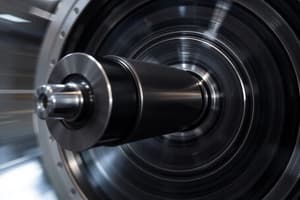Podcast
Questions and Answers
¿Qué término se refiere a la distancia horizontal entre el punto de pivote y la línea central del peso cuando se equilibra un peso en una barra horizontal?
¿Qué término se refiere a la distancia horizontal entre el punto de pivote y la línea central del peso cuando se equilibra un peso en una barra horizontal?
- Distancia radial
- Momento de fuerza
- Fuerza rotacional
- Brazo de palanca (correct)
¿Qué representa el término 'brazo de palanca' en el contexto del torque?
¿Qué representa el término 'brazo de palanca' en el contexto del torque?
- La magnitud de la fuerza aplicada
- La distancia perpendicular desde la línea de acción de la fuerza al eje (correct)
- La distancia paralela al eje de rotación
- La velocidad angular generada
Según la ecuación del torque, ¿qué factor determina principalmente la cantidad de torque generado por una fuerza?
Según la ecuación del torque, ¿qué factor determina principalmente la cantidad de torque generado por una fuerza?
- La magnitud de la fuerza perpendicular al eje de rotación (correct)
- La dirección de la fuerza aplicada
- La resistencia del objeto al giro
- La rapidez de la rotación
En el contexto del torque, ¿qué representa el 'momento arm'?
En el contexto del torque, ¿qué representa el 'momento arm'?
¿Cómo se calcula el torque actuando sobre un objeto cuando una fuerza \(\mathbf{F}\) actúa a un ángulo \(\theta\) respecto a un eje fijo?
¿Cómo se calcula el torque actuando sobre un objeto cuando una fuerza \(\mathbf{F}\) actúa a un ángulo \(\theta\) respecto a un eje fijo?
¿Qué se entiende por el término 'fuerza de torsión' en el contexto biológico?
¿Qué se entiende por el término 'fuerza de torsión' en el contexto biológico?
¿Qué papel desempeña el brazo de palanca en la generación de torque?
¿Qué papel desempeña el brazo de palanca en la generación de torque?
¿Cuál es un ejemplo de torque positivo en una articulación durante la locomoción humana?
¿Cuál es un ejemplo de torque positivo en una articulación durante la locomoción humana?
¿Por qué es importante el concepto de momento arm en la comprensión de la generación de torque en actividad física?
¿Por qué es importante el concepto de momento arm en la comprensión de la generación de torque en actividad física?
¿Cuál es el impacto del torque negativo generado por los músculos flexores del codo en la articulación para ejecutar un movimiento?
¿Cuál es el impacto del torque negativo generado por los músculos flexores del codo en la articulación para ejecutar un movimiento?
Flashcards are hidden until you start studying
Study Notes
Torque: A Force's Rotational Companion
Torque is an essential concept when studying motion around axes and rotation within mechanical systems. It represents the turning effect of forces applied at some distance from an axis—a fundamental aspect in our understanding of levers, machines, and even biological processes like human movement.
Lever Arm & Moment Arm
Let's begin with two terms closely related to torque: lever arm and moment arm. When you balance a weight on a horizontal bar suspended by a fulcrum, this horizontal length between the pivot point and the weight's centerline is its lever arm, also known as the distance of application. Similarly, when discussing torque, we refer to the perpendicular distance from the line along which the force acts to the axis as the moment arm. This length determines how effectively a given force can generate rotation. In essence, the longer the moment arm, the more significant the torque produced by a force.
Torque Equation
To define torque mathematically, consider a force (\mathbf{F}) acting on an object at an angle (\theta) relative to a fixed reference line called the axis of rotation. Torque ((T)) is calculated using the following formula:
[ T = Fd_{\text{perpendicular}} = F_\perp d ]
where (d_\perp) equals the product of the magnitude of the force component perpendicular to the axis, (F_\perp), and the moment arm, (d).
Rotational Force
Now, imagine lifting a heavy box while standing still; your muscles contribute a vertical upward force, but due to their attachment points (connected to bones), they exert a couple of forces whose lines of action form moments relative to joint centers. These combinations of forces and their interactions through moment arms create what we call rotational forces or simply torques. Thus, torque plays a vital role in understanding the dynamics behind biological movements too.
Torque en los Huesos
In the context of human biology, torque becomes crucial in understanding limb function, muscle activation patterns, and coordination during various activities such as walking, running, jumping, throwing, etc.. As previously mentioned, when muscular forces act upon bony attachments, these pairs of forces, together with their respective moment arms, produce torque about different joint centers. For example, in locomotion, hip extensors like gluteal muscles create positive torque at the hip joint, causing it to extend, while knee flexor groups like hamstrings generate negative torque at the knee joint, allowing it to bend.
The study of torque has diverse applications across engineering, physics, and biology fields. By understanding and applying principles related to torque, engineers design mechanisms capable of producing desired rotations and motions. Biologists analyze complex functional relationships among skeletal structures, muscles, tendons, ligaments, nervous system control, and energetic demands underpinning animal behavior. And physicians diagnose and rehabilitate patients suffering from injuries affecting mobility and muscle performance based on quantifying abnormalities in torque generation and utilization.
Studying That Suits You
Use AI to generate personalized quizzes and flashcards to suit your learning preferences.




